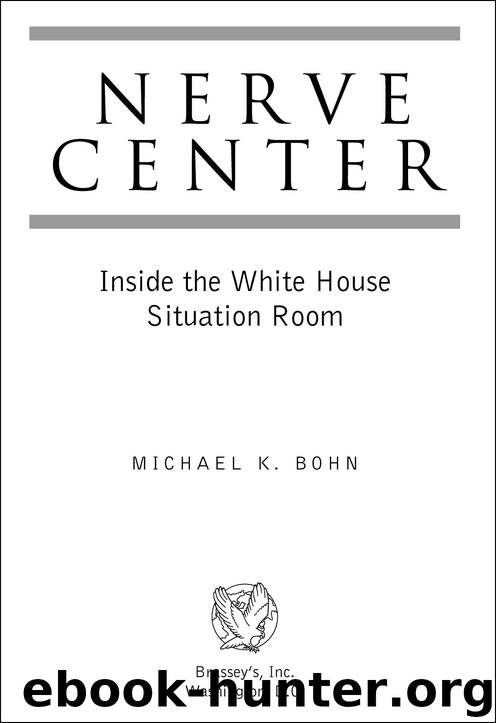Nerve Center by Bohn Michael K

Author:Bohn, Michael K.
Language: eng
Format: epub
Publisher: Potomac Books Inc.
Published: 2003-04-14T16:00:00+00:00
6
CRISIS
MANAGEMENT
War and Terrorism
“The President has been shot!”
Those words echoed through the halls of the White House on March 30, 1981. Just ten weeks after Ronald Reagan’s inauguration, John W. Hinckley, Jr., shot the President outside the Washington Hilton hotel in Washington, D.C. Reagan was seriously wounded and the Secret Service rushed him to nearby George Washington University Hospital.
While Reagan’s chief of staff, Jim Baker, and presidential counselor, Ed Meese, followed Reagan to the hospital, a gaggle of other senior advisers gathered in the Situation Room to “manage” the crisis. Richard V. Allen, the first of Reagan’s six national security advisers, placed a small tape recorder on the table in the conference room and proceeded to record the group’s deliberations. Allen released the tape recording in March 2001 on the twentieth anniversary of the assassination attempt, generating a good bit of news media and political interest. The reason was that the participants, the most senior national security officials in the government, seemed to be tense and ill informed. Perhaps unnerved by the potential consequences to the country if the President died, or even unsure of their roles just two months into the presidency, some of them did not sound like the kind of crisis managers the American public might want in the White House Situation Room. Showtime aired a film on cable television about the Reagan assassination attempt in December 2001 and it highlighted what a reviewer labeled “chaos” in the Situation Room. Allen criticized both the film and the characterization of the proceedings as chaotic, but writer/director Cyrus Nowrasteh defended his dramatization of the event.
During the first hour after Reagan’s shooting, the group in the Situation Room was unaware of the severity of the President’s wounds. They did not know if Hinckley had acted alone, or if the assassination attempt was part of a larger attack. Further, Vice President Bush was traveling, and thus unable to either immediately take temporary control of the government if Reagan were incapacitated, or to be present to succeed Reagan if the President died. Secretary of Defense Casper Weinberger wanted to increase the readiness of the Armed Forces and argued with Secretary of State and retired four-star General Alexander Haig about what actions should be taken. The two had a tense discussion about the need to have a “football” in the Situation Room, the briefcase containing nuclear weapons release codes that military personnel kept close to both the President and Vice President. One participant, Secretary of the Treasury Donald Regan, even thought about the political consequences of the assassination attempt and suggested getting out front on the right side of the handgun debate.
But the issue that got most of the news media’s attention during those nervous hours in the Situation Room was the subject of presidential succession. Secretary of State Haig apparently forgot that, after the Vice President, the constitutionally mandated order of succession went through the Speaker of the House and President Pro Tem of the Senate before reaching the Secretary of State. Perhaps erroneously thinking that he was next in line, Haig declared, “The helm is right here.
Download
This site does not store any files on its server. We only index and link to content provided by other sites. Please contact the content providers to delete copyright contents if any and email us, we'll remove relevant links or contents immediately.
| Africa | Americas |
| Arctic & Antarctica | Asia |
| Australia & Oceania | Europe |
| Middle East | Russia |
| United States | World |
| Ancient Civilizations | Military |
| Historical Study & Educational Resources |
The Radium Girls by Kate Moore(11921)
100 Deadly Skills by Clint Emerson(4840)
Rise and Kill First by Ronen Bergman(4704)
The Templars by Dan Jones(4628)
The Doomsday Machine by Daniel Ellsberg(4416)
The Rape of Nanking by Iris Chang(4138)
Killing England by Bill O'Reilly(3951)
Hitler in Los Angeles by Steven J. Ross(3900)
Stalin by Stephen Kotkin(3875)
12 Strong by Doug Stanton(3508)
Hitler's Monsters by Eric Kurlander(3268)
Blood and Sand by Alex Von Tunzelmann(3138)
The Code Book by Simon Singh(3074)
Darkest Hour by Anthony McCarten(3071)
The Art of War Visualized by Jessica Hagy(2943)
Hitler's Flying Saucers: A Guide to German Flying Discs of the Second World War by Stevens Henry(2715)
Babylon's Ark by Lawrence Anthony(2620)
The Second World Wars by Victor Davis Hanson(2482)
Tobruk by Peter Fitzsimons(2444)
